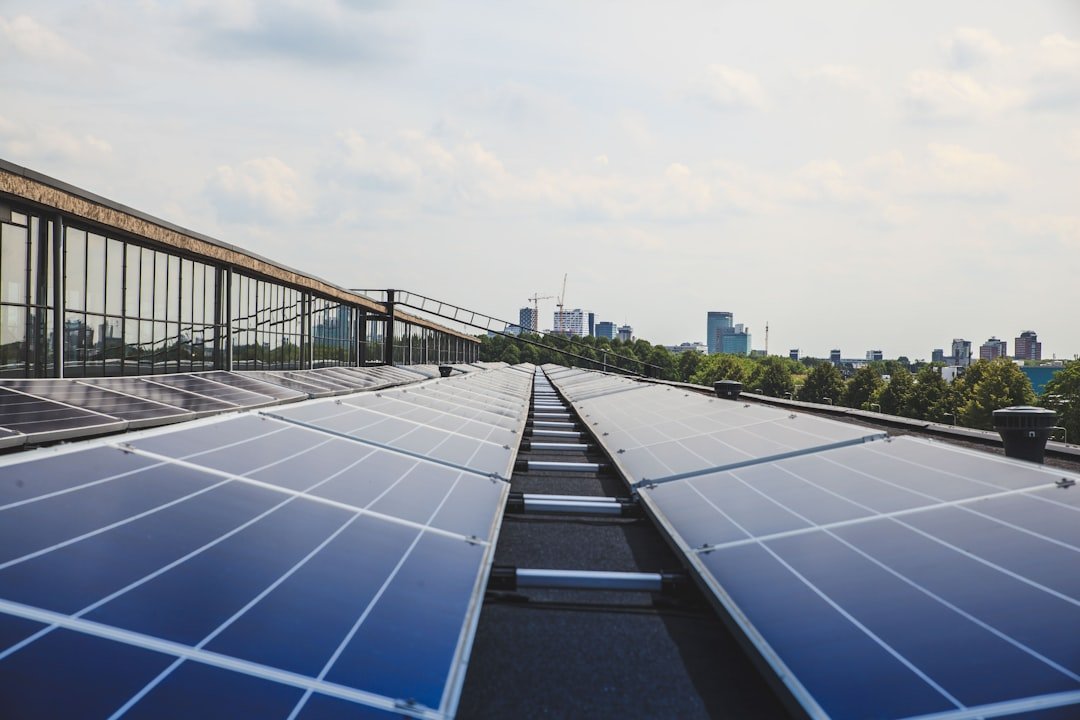Renewable Energy in Disaster Recovery: A Route to Resilience The necessity for efficient recovery plans has been highlighted in recent years by the rise in the frequency & severity of natural disasters. Integrating renewable energy sources into disaster recovery efforts has emerged as a promising solution as communities deal with the aftermath of earthquakes, floods, wildfires, and hurricanes. Renewable energy provides a sustainable substitute for conventional fossil fuels since it is produced by naturally occurring processes that are continuously replenished, such as hydroelectric, wind, and solar power. In addition to meeting immediate energy needs, this change helps build long-term resilience against calamities.
Key Takeaways
- Renewable energy plays a crucial role in disaster recovery by providing sustainable and reliable power sources in the aftermath of natural disasters.
- Implementing renewable energy in disaster recovery efforts brings numerous benefits, including increased resilience, reduced reliance on fossil fuels, and lower long-term costs.
- Successful case studies of renewable energy integration in disaster recovery highlight the effectiveness of solar, wind, and microgrid systems in providing power to affected areas.
- Despite the benefits, challenges and barriers to implementing renewable energy in disaster recovery include high initial costs, technical limitations, and regulatory hurdles.
- Policy and funding support, as well as community engagement and education, are essential for promoting the adoption of renewable energy in disaster recovery efforts and building resilience in vulnerable communities.
Policymakers, environmentalists, and community leaders are all becoming more and more interested in the idea of using renewable energy in disaster recovery. Through the utilization of renewable resources, communities can lessen their reliance on energy infrastructures that are susceptible to disruptions during emergencies. This article examines the various facets of renewable energy’s contribution to disaster recovery, stressing its advantages, difficulties, and prospects for further development in this crucial field. By offering dependable and sustainable power sources in times of emergency, renewable energy plays a critical role in improving disaster resilience. Because they are frequently centralized, traditional energy systems are vulnerable to damage from severe weather conditions.
Decentralized renewable energy systems, on the other hand, enable localized power generation that is less susceptible to interruptions. For example, rooftop solar panels can guarantee that vital services like hospitals & emergency shelters stay open by producing electricity even in the event that the larger grid goes down. A sense of community empowerment is also promoted by incorporating renewable energy into disaster recovery initiatives. By funding regional renewable energy initiatives, communities can take control of their energy requirements and lessen their dependency on outside resources, which might not react quickly in an emergency.
By generating employment in the renewable energy industry, this regional strategy not only improves energy security but also fosters economic resilience. Using renewable technologies can help communities recover from disasters and create a more self-sufficient and sustainable future. The advantages of using renewable energy in disaster recovery activities go beyond just providing instant electricity.
| Metrics | Data |
|---|---|
| Renewable Energy Capacity | 1000 MW |
| Renewable Energy Investment | 1.5 billion |
| Renewable Energy Jobs Created | 5000 |
| Renewable Energy CO2 Emissions Avoided | 2 million tons |
The decrease in greenhouse gas emissions linked to conventional energy sources is one important benefit. Communities can address the urgent problem of climate change & reduce their carbon footprint by switching to renewable energy sources. Given that climate change is making natural disasters more frequent and severe, this dual benefit is especially important. More often than not, renewable energy systems are less expensive to operate and maintain than traditional fossil fuel-based systems.
Wind turbines and solar panels can produce electricity with little continuing cost once they are installed. Communities recuperating from disasters that may have put a strain on their financial resources should pay particular attention to this cost-effectiveness. These communities can save money in the long run and guarantee a steady supply of energy for many years to come by investing in renewable energy infrastructure. The effective incorporation of renewable energy into global disaster recovery initiatives is demonstrated by a number of case studies. Hurricane Maria’s aftermath in Puerto Rico in 2017 is one prominent example. Millions of people were left without power for months after the hurricane destroyed the island’s electrical grid.
In response, numerous local governments and organizations started initiatives to set up solar microgrids all over the island. In addition to offering immediate assistance by bringing power back to vital infrastructure, these microgrids set the stage for a more robust energy system that would be able to weather future storms. The aftermath of Hurricane Katrina in 2005 in New Orleans provides yet another strong argument. Rebuilding the city’s infrastructure, including its energy systems, presented many difficulties. Since the tragedy, New Orleans has embraced renewable energy projects, such as installing solar panels on residences and public buildings.
Along with increasing access to energy, these initiatives have raised community awareness of sustainability issues and encouraged community involvement. The city is now a leader in resilience and disaster recovery thanks to its dedication to renewable energy. There are still a number of obstacles & difficulties in incorporating renewable energy into disaster recovery initiatives, despite the many benefits. A major obstacle is the initial financial outlay needed for infrastructure related to renewable energy. Even though there are clear long-term savings, many communities might find it difficult to afford the initial expenditures of installing solar panels, wind turbines, or other renewable technologies.
This monetary obstacle may impede development & postpone the adoption of urgently needed energy solutions. Also, the quick installation of renewable energy systems in disaster-affected areas might not always be supported by legal frameworks and policies. In addition to impeding cooperation amongst the different stakeholders involved in recovery efforts, bureaucratic red tape can slow down project approvals. Community members may also lack the technical know-how necessary to successfully plan and carry out renewable energy projects. Governmental organizations, nonprofits, and private sector partners must work together to address these issues and establish an atmosphere that encourages the use of renewable energy.
Strong legislative frameworks and financial assistance are necessary to overcome the obstacles related to the use of renewable energy in disaster recovery. Establishing incentives for investments in renewable energy, such as tax credits or grants for disaster-affected communities, is an important role that governments at all levels can play. These financial incentives can support local governments and organizations in pursuing renewable projects by easing the initial cost burden.
Financial Rewards for Renewable Energy. To entice local governments and organizations to invest in renewable energy projects, governments can provide financial incentives like grants or tax credits. This can encourage the use of renewable energy sources and lessen the financial burden of upfront expenditures. Making the Permitting Process Simpler.
During recovery efforts, policies that expedite the permitting process for renewable energy installations can speed up deployment. Communities can quickly implement solutions that improve resilience and restore power by lowering bureaucratic barriers. Partnerships that Work Together for Successful Disaster Recovery.
Cooperation amongst government agencies, private businesses, and nonprofit groups can encourage resource sharing and innovation, which will ultimately result in more successful renewable energy-based disaster recovery plans. In order to successfully integrate renewable energy into disaster recovery efforts, community engagement and education are essential elements. Projects are guaranteed to be in line with community needs and priorities when locals are included in decision-making processes. Involving stakeholders from a range of backgrounds promotes active participation in the implementation of renewable initiatives & a sense of ownership over them.
In order to increase public awareness of the advantages of renewable energy sources and their possible influence on disaster resilience, education is essential. Through workshops, informational meetings, and outreach initiatives, community members can gain knowledge about funding opportunities and available technologies. Communities can create a culture of sustainability that goes beyond immediate recovery efforts by educating people about how they can support disaster recovery through renewable energy initiatives. As technology develops further, the prospects for renewable energy in disaster recovery appear bright. Renewable energy sources are becoming more reliable thanks to innovations like battery storage systems, which store extra energy produced during periods of high production for later use.
This feature is especially helpful in emergency situations where there is a spike in demand for electricity because of a greater need for cooling systems or medical equipment. In addition, the necessity for resilient, sustainable solutions is becoming more widely acknowledged as climate change continues to threaten communities around the globe. Incorporating renewable energy into disaster recovery initiatives supports international sustainability objectives and offers chances for cooperation between countries dealing with related issues. Communities can work together to advance their efforts toward creating a more resilient future driven by clean energy by exchanging best practices & insights from successful case studies.
In summary, incorporating renewable energy into disaster recovery initiatives is a game-changing strategy that supports long-term resilience against upcoming difficulties in addition to meeting immediate needs. By removing obstacles with the help of innovative technologies, community involvement, and policy support, societies can use renewable energy to develop sustainable solutions that uplift people and fortify communities during emergencies.



